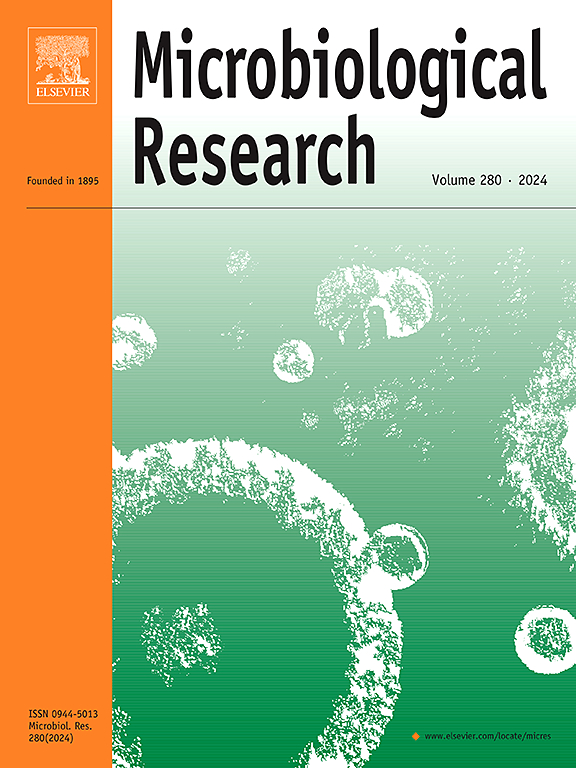整体突变扫描揭示了 MCR-1 机制作用的重要活性残基
IF 6.1
1区 生物学
Q1 MICROBIOLOGY
引用次数: 0
摘要
多粘菌素(包括可乐定和多粘菌素 B)是治疗耐碳青霉烯类肠杆菌(CRE)感染的最后一种重要抗生素。然而,可乐定耐药基因(mcr-1)的迅速扩散对多粘菌素的疗效提出了挑战。mcr-1 基因编码一种跨膜磷乙醇胺(PEA)转移酶,即 MCR-1。MCR-1 可催化磷脂酰乙醇胺(PE)的 PEA 分子转移到脂质 A 的 1'(或 4')-磷酸基团上。尽管已确定了 MCR-1 可溶性结构域的多个结构,但人们对整体 MCR-1 的结构和生化机制仍不甚了解。在这项研究中,我们利用丙氨酸扫描诱变方法系统地研究了 MCR-1 不同区域的功能属性。我们确定了 15 个关键残基,这些残基对 MCR-1 的酶活性不可或缺,也是 MCR-1 赋予可乐定抗性的关键。此外,MCR-1 与磷脂酰乙醇胺(PE)底物复合物的分子对接显示了一个通道形空腔的存在,这是与其他磷脂酰乙醇胺转移酶共有的特征。尽管 MCR-1 与 MCR 同源物和其他磷脂酰乙醇胺(PEA)转移酶的序列相似性较低,但还是发现了几个保守位点,包括 Y97、M105、K333、H395、L477 和 H478,这表明它们之间可能存在共同的催化机制来修饰 LPS-脂质 A。此外,这些发现还提供了坚实的结构和功能基础,有助于合理设计靶向抑制剂,恢复可乐定对耐碳青霉烯类肠杆菌(CRE)严重感染的活性。本文章由计算机程序翻译,如有差异,请以英文原文为准。
Overall mutational scanning unveils the essential active residues for the mechanistic action of MCR-1
Polymyxins, including colistin and polymyxin B, serve as crucial last-resort antibiotics for managing infections caused by carbapenem-resistant Enterobacterales (CRE). However, the rapid spread of the mobilized colistin resistance gene (mcr-1) challenged the efficacy of treatment by polymyxins. The mcr-1 gene encoded a transmembrane phosphoethanolamine (PEA) transferase enzyme, MCR-1. MCR-1 could catalyze the transfer of PEA moiety of phosphatidylethanolamine (PE) to the 1’ (or 4’)-phosphate group of the lipid A. Despite the determination of several structures of the soluble domain of MCR-1, the structural and biochemical mechanisms of integral MCR-1 remain less understood. In this study, we utilized an alanine scanning mutagenesis approach to systematically investigate the functional attributes of distinct regions within MCR-1. We identified fifteen critical residues that are indispensable for the enzymatic activity of MCR-1 and are pivotal for its ability to confer resistance to colistin. Furthermore, molecular docking of MCR-1 complexed with the phosphoethanolamine (PE) substrate revealed the presence of a channel-shaped cavity, a characteristic feature shared with other phosphoethanolamine transferases. Despite MCR-1 exhibiting a low sequence identity with both MCR homologues and other phosphoethanolamine (PEA) transferases, several conserved sites were identified, including Y97, M105, K333, H395, L477, and H478, suggesting a potentially shared catalytic mechanism among them for modifying LPS-lipid A. Overall, these findings provide a deep understanding of the catalytic mechanism of MCR-1 for colistin resistance. Moreover, these findings provide a robust structural and functional foundation, enabling the rational design of targeted inhibitors and restoring colistin activity against serious infections with carbapenem-resistant Enterobacterales (CRE).
求助全文
通过发布文献求助,成功后即可免费获取论文全文。
去求助
来源期刊

Microbiological research
生物-微生物学
CiteScore
10.90
自引率
6.00%
发文量
249
审稿时长
29 days
期刊介绍:
Microbiological Research is devoted to publishing reports on prokaryotic and eukaryotic microorganisms such as yeasts, fungi, bacteria, archaea, and protozoa. Research on interactions between pathogenic microorganisms and their environment or hosts are also covered.
 求助内容:
求助内容: 应助结果提醒方式:
应助结果提醒方式:


